
Physics is a branch of science whose primary objects of study are matter and energy. Discoveries of physics find applications throughout the natural sciences and in technology. Physics today may be divided loosely into classical physics and modern physics.
Inertia is the idea that an object will continue its current motion until some force causes its speed or direction to change. The term is properly understood as shorthand for "the principle of inertia" as described by Newton in his first law of motion.

Mass is an intrinsic property of a body. It was traditionally believed to be related to the quantity of matter in a physical body, until the discovery of the atom and particle physics. It was found that different atoms and different elementary particles, theoretically with the same amount of matter, have nonetheless different masses. Mass in modern physics has multiple definitions which are conceptually distinct, but physically equivalent. Mass can be experimentally defined as a measure of the body's inertia, meaning the resistance to acceleration when a net force is applied. The object's mass also determines the strength of its gravitational attraction to other bodies.
Mechanics is the area of mathematics and physics concerned with the relationships between force, matter, and motion among physical objects. Forces applied to objects result in displacements, or changes of an object's position relative to its environment.

Physics is the natural science that studies matter, its fundamental constituents, its motion and behavior through space and time, and the related entities of energy and force. Physics is one of the most fundamental scientific disciplines, with its main goal being to understand how the universe behaves. A scientist who specializes in the field of physics is called a physicist.

In physics, gravity (from Latin gravitas 'weight') is a fundamental interaction which causes mutual attraction between all things with mass or energy. Gravity is, by far, the weakest of the four fundamental interactions, approximately 1038 times weaker than the strong interaction, 1036 times weaker than the electromagnetic force and 1029 times weaker than the weak interaction. As a result, it has no significant influence at the level of subatomic particles. However, gravity is the most significant interaction between objects at the macroscopic scale, and it determines the motion of planets, stars, galaxies, and even light.

Simon Stevin, sometimes called Stevinus, was a Flemish mathematician, scientist and music theorist. He made various contributions in many areas of science and engineering, both theoretical and practical. He also translated various mathematical terms into Dutch, making it one of the few European languages in which the word for mathematics, wiskunde, was not a loanword from Greek but a calque via Latin. He also replaced the word chemie, the Dutch for chemistry, by scheikunde, made in analogy with wiskunde.
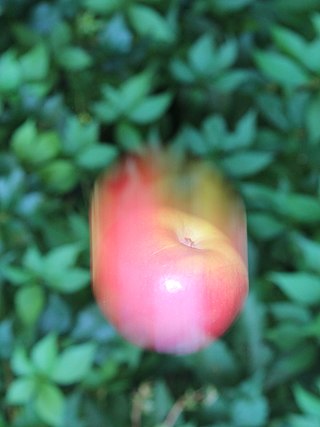
In Newtonian physics, free fall is any motion of a body where gravity is the only force acting upon it. In the context of general relativity, where gravitation is reduced to a space-time curvature, a body in free fall has no force acting on it.

The Discourses and Mathematical Demonstrations Relating to Two New Sciences published in 1638 was Galileo Galilei's final book and a scientific testament covering much of his work in physics over the preceding thirty years. It was written partly in Italian and partly in Latin.
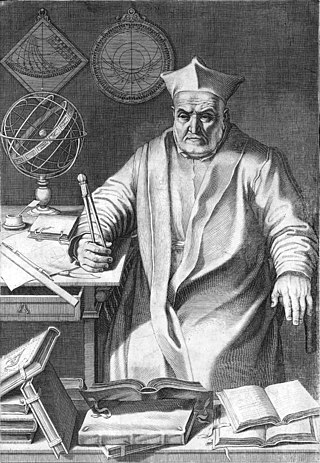
Christopher Clavius, SJ was a Jesuit German mathematician, head of mathematicians at the Collegio Romano, and astronomer who was a member of the Vatican commission that accepted the proposed calendar invented by Aloysius Lilius, that is known as the Gregorian calendar. Clavius would later write defences and an explanation of the reformed calendar, including an emphatic acknowledgement of Lilius' work. In his last years he was probably the most respected astronomer in Europe and his textbooks were used for astronomical education for over fifty years in and even out of Europe.

The Nieuwe Kerk is a Protestant church in the city of Delft in the Netherlands. The building is located on Delft Market Square (Markt), opposite to the City Hall. In 1584, William the Silent was entombed here in a mausoleum designed by Hendrick and Pieter de Keyser. Since then members of the House of Orange-Nassau have been entombed in the royal crypt. The latest are Queen Juliana and her husband Prince Bernhard in 2004. The private royal family crypt is not open to the public. The church tower, with the most recent recreation of the spire which was designed by Pierre Cuypers and completed in 1872, is the second highest in the Netherlands, after the Domtoren in Utrecht.
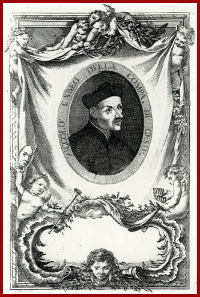
Niccolò Cabeo, SJ was an Italian Jesuit philosopher, theologian, engineer and mathematician.
This article deals with the history of classical mechanics.
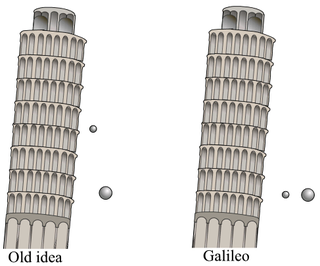
Between 1589 and 1592, the Italian scientist Galileo Galilei is said to have dropped two spheres of the same volume but different masses from the Leaning Tower of Pisa to demonstrate that their time of descent was independent of their mass, according to a biography by Galileo's pupil Vincenzo Viviani, composed in 1654 and published in 1717. The basic premise had already been demonstrated by Italian experimenters a few decades earlier.
Aristotelian physics is the form of natural science described in the works of the Greek philosopher Aristotle. In his work Physics, Aristotle intended to establish general principles of change that govern all natural bodies, both living and inanimate, celestial and terrestrial – including all motion, quantitative change, qualitative change, and substantial change. To Aristotle, 'physics' was a broad field that included subjects that would now be called the philosophy of mind, sensory experience, memory, anatomy and biology. It constitutes the foundation of the thought underlying many of his works.
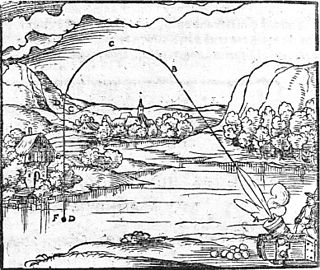
The theory of impetus was an auxiliary or secondary theory of Aristotelian dynamics, put forth initially to explain projectile motion against gravity. It was introduced by John Philoponus in the 6th century, and elaborated by Nur ad-Din al-Bitruji at the end of the 12th century. The theory was modified by Avicenna in the 11th century and Abu'l-Barakāt al-Baghdādī in the 12th century, before it was later established in Western scientific thought by Jean Buridan in the 14th century. It is the intellectual precursor to the concepts of inertia, momentum and acceleration in classical mechanics.

Galileo di Vincenzo Bonaiuti de' Galilei was an Italian astronomer, physicist and engineer, sometimes described as a polymath. Commonly referred to as Galileo, his name was pronounced. He was born in the city of Pisa, then part of the Duchy of Florence. Galileo has been called the "father" of observational astronomy, modern physics, the scientific method, and modern science.
The following is a timeline of the history of the municipality of Delft, Netherlands.

Jacques-Alexandre Le Tenneur was a French mathematician who defended Galileo Galilei’s ideas. He corresponded with fellow mathematicians such as Pierre Gassendi, Pierre Hérigone and Marin Mersenne. It is unclear when or where he died but he probably lived from 1610 to 1660.

Jan Cornets De Groot or Johan Hugo De Groot Latinized as Janus Grotius was a Dutch nobleman and scholar who conducted experiments in physics and explored natural philosophy. Along with Simon Stevin he experimented on the time taken for lead of different weights to fall to the ground to prove Aristotle wrong in the famous Delft tower experiment.















